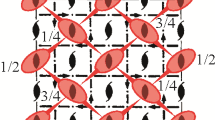Abstract
On the basis of an original interpretation of the crystal state, it is shown that most of the structural types are determined by a small set of planar nets densely filled with the heaviest atoms of the structure. These nets are combined into atomic sublattices (matrices of the structure types) by the operations of (pseudo) symmetry, thus reducing the number of the degrees of freedom in the structure, which, in turn, provides structure stability. It is shown on examples of heavy-cation oxides, fluorides, and sulfides that the number of the types of such matrices (F-, I-, etc.) is limited. Each type is characterized by a certain structure-determining complex of mutually intersecting crystallographic planes parallel to the most densely filled atomic nets. Most of the atomic nets considered in crystal chemistry are, in fact, various sections of the sublattices-matrices formed by a limited number of densely filled atomic nets.
Similar content being viewed by others
References
N. V. Belov, Structure of Ionic Crystals and Metal Phases (Akad. Nauk SSSR, Moscow, 1947), p. 238.
A. F. Wells, Structural Inorganic Chemistry (Clarendon, Oxford, 1984; Mir, Moscow, 1987), Vol. 1, p. 408.
P. I. Kripyakevich, Structure Types of Intermetallic Compounds (Nauka, Moscow, 1977), p. 288.
W. B. Pearson, Crystal Chemistry and Physics of Metals and Alloys (Wiley, New York, 1972; Mir, Moscow, 1977), Chap. 1.
S. V. Borisov, Zh. Strukt. Khim. 34(5), 116 (1992).
S. V. Borisov, Zh. Strukt. Khim. 37(5), 907 (1996).
S. V. Borisov and R. F. Klevtsova, Kristallografiya 32(1), 113 (1987) [Sov. Phys. Crystallogr. 32 (1), 62 (1987)].
N. A. Bliznyuk and S. V. Borisov, Zh. Strukt. Khim. 34(2), 145 (1992).
S. V. Borisov, Zh. Strukt. Khim. 27(3), 164 (1986).
S. V. Borisov, N. A. Bliznyuk, and E. S. Kuklina, Zh. Strukt. Khim. 35(3), 3 (1994).
I. Narai-Sabo, Inorganic Crystallochemistry (Hungary Academy of Sciences, Budapest, 1969).
S. V. Borisov, N. V. Podberezskaya, S. A. Magarill, and N. V. Pervukhina, Zh. Strukt. Khim. 38(5), 908 (1997).
S. V. Borisov, N. V. Podberezskaya, N. V. Pervukhina, and S. A. Magarill, Z. Kristallogr. 213, 253 (1998).
R. F. Klevtsova, S. V. Borisov, N. A. Bliznyuk, et al., Zh. Strukt. Khim. 32(6), 127 (1991).
B. K. Vainshtein and R. L. Kayushina, Kristallografiya 11(4), 526 (1966) [Sov. Phys. Crystallogr. 11 (4), 468 (1966)].
S. V. Borisov, Zh. Strukt. Khim. 38, 1156 (1995).
Author information
Authors and Affiliations
Additional information
__________
Translated from Kristallografiya, Vol. 45, No. 5, 2000, pp. 779–783.
Original Russian Text Copyright © 2000 by Borisov.
Rights and permissions
About this article
Cite this article
Borisov, S.V. Geometrical laws in inorganic chemistry. Crystallogr. Rep. 45, 709–713 (2000). https://doi.org/10.1134/1.1312905
Received:
Issue Date:
DOI: https://doi.org/10.1134/1.1312905




